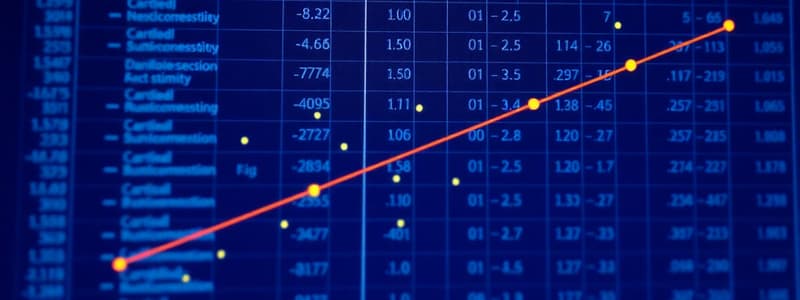Podcast
Questions and Answers
What is the primary focus of correlation in statistics?
What is the primary focus of correlation in statistics?
- To measure the spread of data points
- To evaluate the relationship between two variables (correct)
- To analyze a single variable's behavior
- To compute the average of a data set
What does the term 'central tendency' refer to in statistics?
What does the term 'central tendency' refer to in statistics?
- The number of participants in a study
- The variability of data points
- The average of a set of numbers (correct)
- The relationship between two variables
How would you describe the dimensionality of correlation?
How would you describe the dimensionality of correlation?
- Multivariate as it involves multiple dimensions
- Monodimensional because it involves only one variable
- Unidimensional since it focuses on individual data points
- Bivariate as it involves two dimensions (correct)
In correlation, what does it imply if one variable remains constant while the other changes?
In correlation, what does it imply if one variable remains constant while the other changes?
What is meant by 'dispersion' in the context of statistics?
What is meant by 'dispersion' in the context of statistics?
Which of the following is a measure of central tendency?
Which of the following is a measure of central tendency?
If two variables X and Y are correlated, what does it mean?
If two variables X and Y are correlated, what does it mean?
Which of the following terms describes the average of a set of data points?
Which of the following terms describes the average of a set of data points?
What does the correlation coefficient value represent in the context of data?
What does the correlation coefficient value represent in the context of data?
What is the range of values for a correlation coefficient?
What is the range of values for a correlation coefficient?
What does a correlation coefficient of 0.9 imply about the data relationship?
What does a correlation coefficient of 0.9 imply about the data relationship?
What should you do if your calculated correlation coefficient exceeds 1 or is less than -1?
What should you do if your calculated correlation coefficient exceeds 1 or is less than -1?
In the context of correlation, what is the 'coefficient of determination' used for?
In the context of correlation, what is the 'coefficient of determination' used for?
What does the term 'joint restoration' refer to in the context of correlation?
What does the term 'joint restoration' refer to in the context of correlation?
If a correlation coefficient (R) is negative, what does it indicate?
If a correlation coefficient (R) is negative, what does it indicate?
Why is it important to understand correlation in real-life applications?
Why is it important to understand correlation in real-life applications?
What is implied when the correlation between two independent variables is evaluated and found to be zero?
What is implied when the correlation between two independent variables is evaluated and found to be zero?
Which of the following statements best describes the relationship between shoe size and spelling ability based on the example given?
Which of the following statements best describes the relationship between shoe size and spelling ability based on the example given?
What does a correlation value represent in statistical analysis?
What does a correlation value represent in statistical analysis?
When evaluating the correlation between two variables, what could a positive correlation indicate?
When evaluating the correlation between two variables, what could a positive correlation indicate?
In correlation analysis, what does it mean if a correlation value is significantly close to zero?
In correlation analysis, what does it mean if a correlation value is significantly close to zero?
What is an important consideration when interpreting correlation results?
What is an important consideration when interpreting correlation results?
What is typically required to compute the correlation coefficient between two data sets?
What is typically required to compute the correlation coefficient between two data sets?
Which formula can be used to compute the correlation coefficient?
Which formula can be used to compute the correlation coefficient?
Flashcards
Correlation
Correlation
A measure used in statistics to understand the relationship between two variables. It explores how changes in one variable affect the other.
Central Tendency
Central Tendency
A statistical measure focusing on the center or typical value of a set of data.
Dispersion
Dispersion
A measure of how spread out data is from the central tendency. It helps understand the variability in a dataset.
Mean
Mean
Signup and view all the flashcards
Median
Median
Signup and view all the flashcards
Mode
Mode
Signup and view all the flashcards
Positional Averages
Positional Averages
Signup and view all the flashcards
2D Coordinate System
2D Coordinate System
Signup and view all the flashcards
Correlation Coefficient Range
Correlation Coefficient Range
Signup and view all the flashcards
Positive Correlation
Positive Correlation
Signup and view all the flashcards
Negative Correlation
Negative Correlation
Signup and view all the flashcards
Zero Correlation
Zero Correlation
Signup and view all the flashcards
Coefficient of Determination (R-squared)
Coefficient of Determination (R-squared)
Signup and view all the flashcards
Predictive Power
Predictive Power
Signup and view all the flashcards
Joint Variation
Joint Variation
Signup and view all the flashcards
Variance
Variance
Signup and view all the flashcards
No Linear Relationship
No Linear Relationship
Signup and view all the flashcards
Correlation of Zero
Correlation of Zero
Signup and view all the flashcards
Formula for Correlation Coefficient (r)
Formula for Correlation Coefficient (r)
Signup and view all the flashcards
Irrelevant Data
Irrelevant Data
Signup and view all the flashcards
Sample Correlation Coefficient
Sample Correlation Coefficient
Signup and view all the flashcards
Calculating Correlation
Calculating Correlation
Signup and view all the flashcards
Study Notes
Correlation Introduction
- Correlation describes the relationship between two variables.
- Correlation can be positive, negative, or no correlation.
- Correlation measures the strength and direction of a relationship.
- Correlation values range from -1 to +1.
Correlation and Variables
- Correlation studies how two variables are related.
- Variables can include stats, employee position averages.
- There are two or more possible variables in a relationship.
Correlation and Data
- Data points can be scattered; correlation examines overall patterns.
- Data can be dispersed, with positive and negative values.
- Correlation assesses the relationship's direction and strength.
- Correlation values are affected by the relationship between the variables.
Correlation and Meaning
- Correlation means a relationship between two things.
- It describes the relation between any two things.
- Correlation measures how strongly two variables are related.
Correlation and Significance
- Correlation is essential for practical applications.
- Correlation is necessary for various fields like the market.
- Correlation is used in weather forecasting, etc.
Types of Correlation
- Positive correlation: Both variables increase or decrease together.
- Negative correlation: One variable increases while the other decreases.
- No correlation: No discernable relationship between variables.
Correlation and Calculations
- Correlation coefficients measure correlation strength.
- Correlation values always fall between -1 and 1.
- Various methods exist to calculate correlation.
- R-squared shows the variation explained by the relationship. (R-squared is a measure of fit.)
Correlation and Interpretation
- Correlation signifies the strength and direction of a relationship.
- Magnitude indicates how strongly variables are related.
- Zero variance implies no linear relation between variables.
Additional Concepts
- Data points: Individual data values.
- Scatter diagram: Visual representation of data points.
- Quadrants: Areas in a scatter diagram defined by axes.
- Correlation values and their interpretation (positive, negative, high).
Defining Correlation
- Correlation assesses how changes in one variable relate to changes in another.
- It measures how related variables change together, with a focus on the degree and trend.
Studying That Suits You
Use AI to generate personalized quizzes and flashcards to suit your learning preferences.




